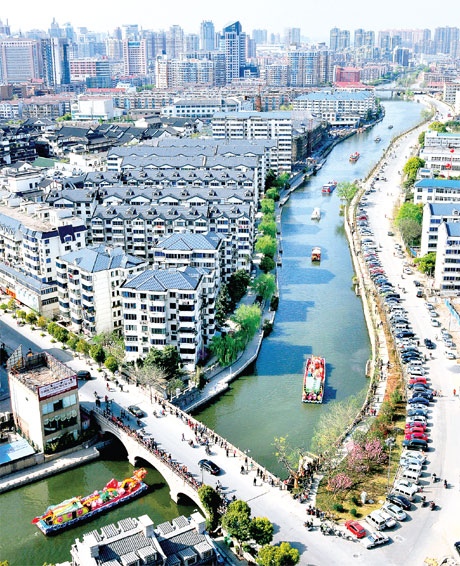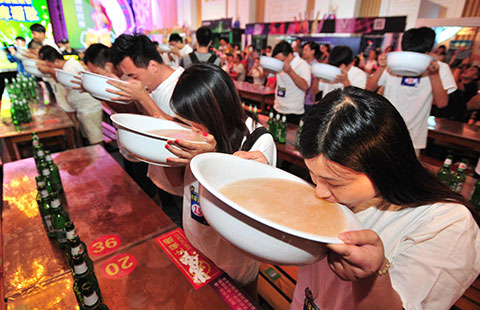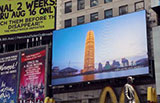City's fortunes flow in tandem with river
(China Daily) Updated: 2014-09-12 07:42Grand Canal: lifeline in the past, heritage in modern times
Throughout history, many cities have prospered because of their proximity to rivers. One such settlement is Wuxi, where the main river has greatly benefited the city's standing.
The Bodu canal was ordered dug for a princess of the royal family 3,000 years ago to transport soldiers and produce and to irrigate farms in Wuxi's suburbs. Today, it is one of the oldest canals in the world that still functions well.
|
China's Grand Canal has a history of 1,400 years and a total length of 2,700 kilometers. But Wuxi claims to be the only city that part of the canal cuts through. Many residents like to own a modern residence overlooking the ancient canal. |
It is now a branch of the Grand Canal that stretches from Beijing to Hangzhou, and is the most important river in Wuxi. The Grand Canal was built 1,400 years ago and is a main water transportation line through the city. The section of the canal in Wuxi is about 20 to 40 meters wide and 40 kilometers long, and connects the Yangtze River in the north with Taihu Lake in the south.
More than 100 small canals have been developed around the main canal in the past 1,000 years, as the city gradually grew from an agricultural production base in ancient China to an industrial center for the country today.
The old Wuxi was famed as the "Venice of the East" for the concentrated river network in the area encircled by its moat.
UNESCO recognized the 2,700-km Grand Canal, which was initially dug to let the emperors of the Sui Dynasty (581-618) travel to southern China faster, as a new World Heritage in June 2014. The news caused the 18 cities along the canal, 800 km of which still functions well today, to compete to claim the UNESCO title and the tourists expected to accompany it.
Although the canal in many of these cities has become a mere showcase, the portion that runs through Wuxi still plays an important part in the city. The close interaction between the canal and Wuxi residents shapes the local culture, lifestyles and economy.
The canal transports rice, coal, tiles, silk and porcelain in peacetime, and has conveyed soldiers, arms and ammunition during wars. It remains one of the busiest canal sections in China today, thanks to the booming tourism and industries of the city.
Wuxi started protecting old residential buildings, schools, shops, temples, ports and bridges along the canal from 1992, earlier than many other cities along the river.
Most of the buildings were built of wood, black tiles, bricks and white lime during the late Qing Dynasty (1644-1911). The government has turned the workshops of a former silk-reeling mill and tile factory into museums of both crafts. Dozens of ancient bridges straddle the river, built in different times and of a variety of styles. Their archways are decorated with embossments and paintings featuring the city's history, giving both pleasure and a visual education to tourists passing under on boats.
A small island called Huangfudun, which is a small hill covered with thick foliage, sits in the upstream of the canal where it enters Wuxi city. The island was previously a port that served as a station for officials coming from north China via the canal.
The canal through Wuxi experienced a dark period from the 1970s through the 1990s, when runoff from chemical factories made its waters polluted and smelly.
The water quality has not recovered completely, despite concerted government efforts to revitalize it over the past 20 years.
Although all factories have been moved out of the old city, the increase of the urban population in Wuxi has aggravated the pollution of the river. The urban population in the city rose from less than half a million in 1949 to more than 6 million now.
To add to the problems for the waterway, the local authority followed central government calls from the 1950s to enlarge grain output and, from the 1950s through the 1970s, filled in rivers to create farmland. Half of the rivers in Wuxi were destroyed. In the late 1970s, the farmland was built over for roads and factories once again.
Many roads in Wuxi curve in a similar way to rivers, because they are indeed built on rivers. Many locals in their late 40s and above, who spent their childhoods beside the rivers, said they feel their memories were buried along with the waterways. Now, the water in most small rivers has become stagnant, because the flow system through the old city that formed gradually since the Sui Dynasty has been destroyed.
- Govt encourages people to work 4.5 days a week
- Action to be taken as HIV cases among students rise
- Debate grows over reproductive rights
- Country's first bishop ordained in 3 years
- China builds Tibetan Buddhism academy in Chengdu
- Authorities require reporting of HIV infections at schools
- Typhoon Soudelor kills 14 in East China
- Police crack down on overseas gambling site
- Debate over death penalty for child traffickers goes on
- Beijing to tighten mail security for war anniversary








